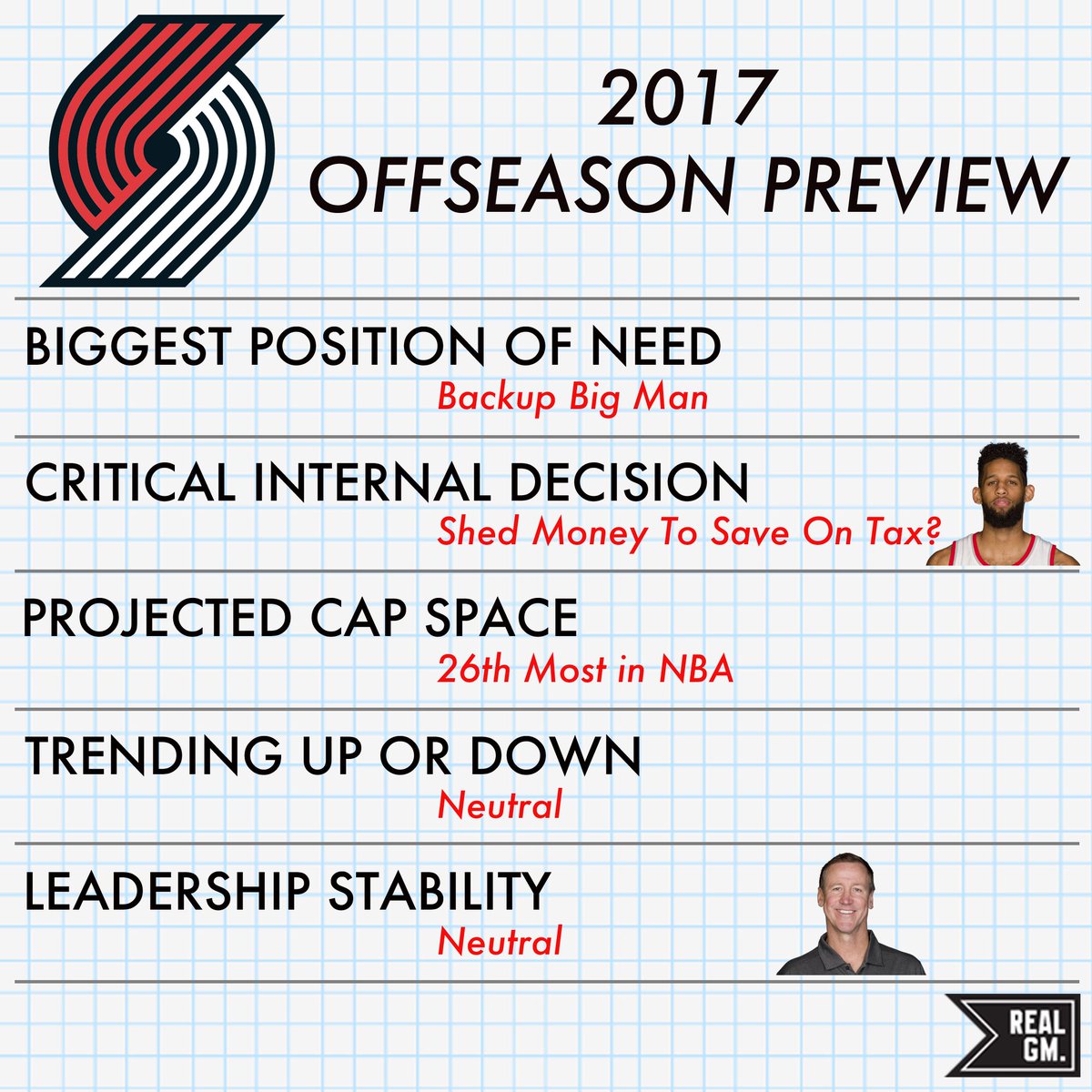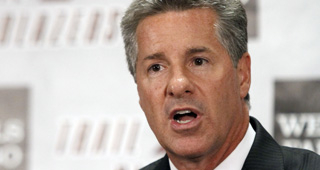After unexpectedly making the playoffs in 2016 following the departure of four starters, the Portland Trail Blazers seized upon their success and invested heavily during free agency. The result was a team that caught no one by surprise and had to scrap until the season’s final days to make the playoffs. The spending spree in 2016 now has the team in a difficult position as we head into the summer of 2017.
With a solid foundation of young players in place, Portland sought to add to that group, while also retaining some of their key rotation pieces. The Trail Blazers signed Evan Turner to a four-year, $70 million deal that encompassed the cap spike and rise in salaries as much as any deal that was signed over the last two summers. Turner was coming off two productive seasons in Boston, where he had become the leader of the Celtics' second unit and a solid crunch time playmaker. It took a while for Turner to adjust to his role with Portland, and he was injured shortly after doing so. When the Blazers put the ball in Turner’s hands, he was a solid enough playmaker. When he was stuck playing off the ball, his inconsistent jump shot became problematic.
The Trail Blazers' other big free agent addition was Festus Ezeli. Unfortunately, Ezeli was never healthy enough to play and missed the entire season. It was a fairly low risk deal for Portland, as the second season in 2017-18 is only guaranteed for $1 million. Nevertheless, it was disappointing that Ezeli couldn’t take the floor, especially when the Blazers could have used a backup center for a large portion of the season.
By way of a salary dump trade with the Orlando Magic, Portland also added Shabazz Napier. A previous salary dump for Maurice Harkless paid off in a big way for Portland, but Napier scarcely played as a backup point guard and didn’t do much when called upon.
With their additions signed, Portland turned towards taking care of their own. They re-signed Harkless and Meyers Leonard in restricted free agency. Harkless signed a four-year, $40 million contract and delivered a solid return on that investment, as he became a full time starter and put up career-highs across the board.
Leonard signed a four-year, $41 million deal and promptly supplied one of the worst seasons of his five-year career. After performing well as a reserve in 2016, Leonard’s shot disappeared and his rebounding fell off in 2017. If he can’t turn it around, that contract will be an albatross on the Portland cap sheet.
The Trail Blazers also matched an offer sheet from the Brooklyn Nets for Allen Crabbe for nearly $75 million over four years. Despite the initial salary figures coming as a shock, Crabbe paid Portland back with the best season of his career. He averaged 10.7 points per game off the bench and shot over 44 percent from behind the arc. Crabbe also improved his playmaking and off the dribble game. While the yearly salary is a large one, Crabbe fits in perfectly in the guard rotation with Damian Lillard and C.J. McCollum.
Lastly, Portland agreed upon a contract extension with McCollum. With McCollum eligible for an extension, he and the Trail Blazers reach agreement on a somewhat creative deal. Rather than wait for max figures to be released, McCollum and Portland agreed to split the difference and locked in a four-year near-max contract. Given his breakout season in 2017, this deal is now favorable for Portland, as McCollum and Lillard are one of the NBA’s better offensive backcourts.
The Blazers also added Jake Layman in a draft day trade and promptly signed him to a three-year contract, which is fully guaranteed the first two years. And Tim Quarterman made the team out of training camp on a two year non-guaranteed contract.
Just before the trade deadline, Portland made a move that helped change the trajectory of their season. The Blazers had been on the fringes of the playoff picture for most of the year and lacked a solid inside scoring presence. With Mason Plumlee a pending restricted free agent, and the cap sheet already precarious, Portland agreed upon a deal with the Denver Nuggets. They acquired Jusuf Nurkic, who had fallen out of the rotation and had become disenchanted with the Nuggets, and a first round pick for Plumlee. Nurkic immediately gave Portland everything they had been missing inside and more. Nurkic suffered a fracture in his leg late in the season and missed three of four playoff games, but the deal was still a clear win for the Blazers.
The story this offseason and quite possibly the next few after that is Portland's cap sheet. With the largest number of guaranteed contracts in the NBA at 12, Portland is in a difficult position. Add to that, three partial/non-guaranteed contracts and the Blazers are the lone NBA team without a single pending free agent on their roster. This can be seen as a good thing, but it limits Portland’s flexibility.
First up, the Trail Blazers will clear a roster spot and about $6.7 million in salary by waiving Ezeli. Connaughton is non-guaranteed until later July, and Quarterman is fully non-guaranteed until the league-wide guaranteed date of January 10th. Both are also signed for the minimum and are highly likely to be brought to training camp.
Beyond that, Portland is severely limited in making additions. They have three first round picks, but they are 15th, 20th and 26th. The likelihood of finding an immediate rotation player during that section of the draft is fairly small. But the picks do allow Portland to ability to shed a contract by attaching one of these extra first rounders to move someone who no longer fits. If they keep all three picks, at least one is likely to be used on a draft and stash player, who will stay overseas for at least a year.
Because they're well into the luxury tax, the Blazers will be limited to the Taxpayer Mid-Level Exception of just over $5.1 million. With the payroll already extremely high, it is unlikely Portland will use this exception, unless they are able to shed some other salary first.
As if that wasn’t enough, the Trail Blazers also have Napier, Nurkic and Noah Vonleh, who has developed into the starting power forward, eligible for contract extensions. It is pretty clear that Napier will not receive an extension, but Nurkic and Vonleh are both prime candidates to get an extension. Portland has no viable means of improvement externally due to their cap situation, and both players are key rotation pieces.
It is all well and good to pay heavily into the future, and to cross the tax line, to keep a team together. This is the strategy many wish the Oklahoma City Thunder had taken versus trading away James Harden. But that Thunder team had been in The Finals and had two other superstars in Kevin Durant and Russell Westbrook. Lillard is a star and McCollum is on his way, but the rest of the Blazers' roster is limited to high-performing role players. The Blazers now have an expensive team with limited flexibility. Neil Olshey has his work cut out for him to improve a roster that seems good enough to win 45-50 games, but is well shy of being a title contender.
Offseason Details
Guaranteed Contracts (12): Al-Farouq Aminu, Allen Crabbe, Ed Davis, Maurice Harkless, Jake Layman, Meyers Leonard, Damian Lillard, C.J. McCollum, Shabazz Napier, Jusuf Nurkic, Evan Turner, Noah Vonleh
Partial/Non-Guaranteed Contracts (3): Pat Connaughton, Festus Ezeli, Tim Quarterman
Potential Free Agents (0): None
“Dead” Money on Cap (1): $1,984,005 (Anderson Varejao)
First Round Draft Pick(s): Pick #15, Pick #20, Pick #26
Maximum Cap Space: None. $31,928,775 over
Projected Cap Space: None. $40,403,648 over




